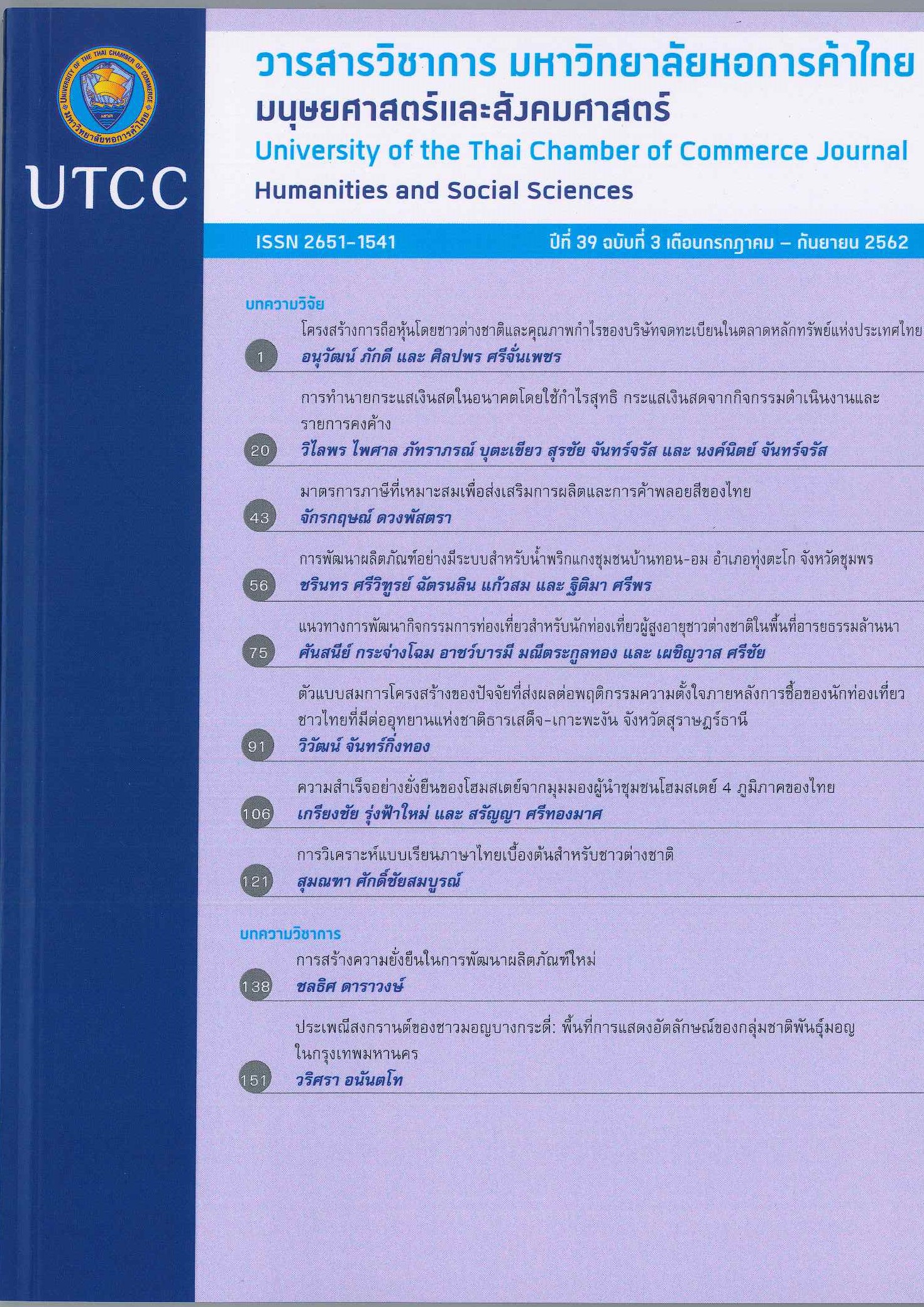Predicting Future Cash Flows by Earnings, Cash Flow from Operation and Accruals
Main Article Content
Abstract
The purpose of this study is to examine the ability of earnings, cash flow from operation and accruals (by two traditional measures of cash flows namely net earnings plus depreciation and amortization expense, and working capital from operation) in predicting future cash flows by using Farshadfar, Ng, and Brimble (2008); Takhtaei and Karimi (2013). This study used panel data from Thomson Reuters Datastream. The sample includes 160 listed companies in the Stock Exchange of Thailand during the period 2005-2016 (1,920 sample firms). The study applied the ordinary least square, both within-sample and out-of-sample to test the hypothesis. The results indicated that net earnings, cash flow from operation and accruals have predictability of the future cash flow at the significant level 0.01. These findings are consistent with Financial Accounting Standards Board (FASB) claim based on earnings in preference on cash flows in predicting future cash flows. Furthermore, the comparison results revealed that net earnings plus depreciation and amortization expense have the better predictive ability of future cash flow, rather than net earnings and cash flow from operation, and working capital from operation, respectively.
Article Details
ลิขสิทธิ์ของบทความ
ผลงานที่ได้รับการตีพิมพ์ถือเป็นลิขสิทธิ์ของมหาวิทยาลัยหอการค้าไทย ห้ามมิให้นำเนื้อหา ทัศนะ หรือข้อคิดเห็นใด ๆ ของผลงานไปทำซ้ำ ดัดแปลง หรือเผยแพร่ ไม่ว่าทั้งหมดหรือบางส่วนโดยไม่ได้รับอนุญาตเป็นลายลักษณ์อักษรจากมหาวิทยาลัยหอการค้าไทยก่อน
References
ภูริษา พงษ์ไทกุล. (2553). ความสามารถของกำไรสุทธิและองค์ประกอบของกำไรสุทธิที่ใช้อธิบายกระแสเงินสดจากการดำเนินงานในอนาคตของบริษัทจดทะเบียนในตลาดหลักทรัพย์ เอ็ม เอ ไอ (การศึกษาอิสระปริญญามหาบัณฑิต ไม่ได้ตีพิมพ์). มหาวิทยาลัยเกษตรศาสตร์, กรุงเทพฯ.
มณฑา สุทธิพงศ์. (2553). กำไรสุทธิ กระแสเงินสดจากการดำเนินงานและรายการคงค้างทางบัญชีในการพยากรณ์กระแสเงินสดจากการดำเนินงานในอนาคต (วิทยานิพนธ์ปริญญามหาบัณฑิต ไม่ได้ตีพิมพ์). มหาวิทยาลัยเกษตรศาสตร์, กรุงเทพฯ.
ศรัญญา คมขุนทด. (2555). ปัจจัยที่มีผลต่อการจัดการกำไรผ่านรายการคงค้างของบริษัทจดทะเบียนในตลาดหลักทรัพย์แห่งประเทศไทยที่ถูกสั่งให้แก้ไขงบการเงิน (วิทยานิพนธ์ปริญญามหาบัณฑิต ไม่ได้ตีพิมพ์). มหาวิทยาลัยขอนแก่น.
สภาวิชาชีพบัญชีในพระบรมราชูปถัมภ์. (2558ก). มาตรฐานการบัญชีฉบับที่ 1 (ปรับปรุง 2558) เรื่อง การนำเสนองบการเงิน. สืบค้นเมื่อ 16 กันยายน 2558, จาก http://www.fap.or.th/upload/9414/Leck7pyxuW.pdf
สภาวิชาชีพบัญชีในพระบรมราชูปถัมภ์. (2558ข). กรอบแนวคิดสำหรับการรายงานทางการเงิน (ปรับปรุง 2558). สืบค้นเมื่อ 20 พฤศจิกายน 2558, จาก http://www.fap.or.th/upload/9414/UW0ynKPwuW.pdf
สภาวิชาชีพบัญชีในพระบรมราชูปถัมภ์. (2558ค). มาตรฐานการบัญชีฉบับที่ 7 (ปรับปรุง2558) เรื่อง งบกระแสเงินสด. สืบค้นเมื่อ 25 กันยายน 2558, จาก http://www.fap.or.th/upload/9414/aFDvyWqQ1F.pdf
สิงห์ชัย อรุณวุฒิพงศ์. (2552). มาตรฐานการบัญชีไทยในปัจจุบันและ IFRS และสรุปมาตรฐานการบัญชีที่มีการปรับปรุงปี 2552. สืบค้นเมื่อ 2 มีนาคม 2558, จากhttp://www.christian.ac.th/train/2010_10_CPD_TA/_53.pdf
อัครพงศ์ อั้นทอง. (2550). คู่มือการใช้โปรแกรม EViews เบื้องต้น: สำหรับการวิเคราะห์ทาง เศรษฐมิติ. สืบค้นเมื่อ 1 มีนาคม 2559, จาก https://piboonrungroj.files.wordpress.com/2011/08/akarapong_handbook_eviews_basic_econometrics.pdf
Barth, M.E., Cram, D.P., & Nelson, K.K. (2001). Accruals and the prediction of future cash flows. The Accounting Review, 76(1), 27-58.
Bowen, R.M., Burgstahler, D., & Daley, L.A. (1986). Evidence on the relationships between earnings and various measures of cash flow. The Accounting Review, 61(4), 713-725.
Curran, J., West, G., & Finch, F. (1996). The robustness of test statistic to nonnormality and specification error in confirmatory factor analysis. Psychological Methods, 14(1), 16-29.
Dechow, P.M., Kothari, S.P., & Watts, R.L. (1998). The relation between earnings and cash flows. Journal of Accounting & Economics, 25(2), 133-168.
Devore, J., & Peck, R. (1993). Statistics: The exploration and analysis of data (2nd ed.). Belmont, CA: Duxbury.
Dixon, W.J. (1960). Simplified estimation from censored normal samples. The Annals of Mathematical Statistics, 31(2), 385-391.
Farshadfar, S., Ng, C., & Brimble, M. (2008). The relative ability of earnings and cash flow data in forecasting future cash flows: Some Australian evidence. Pacific Accounting Review, 20(3), 254-268.
Financial Accounting Standard Board. (1978). Statement of financial accounting concepts no. 1: Objectives of financial reporting by business enterprises. Retrieved September 25, 2013, from http://www.fasb.org/resources/ccurl/816/894/aop_CON1.pdf
Gujarati, D.N., & Porter, D.C. (2010). Essentials of econometrics (4th ed.). Singapore: MaGraw-Hill.
Kim, M., & Kross, W. (2005). The ability of earning to predict future operating cash flows has been increasing-not decreasing. Journal of Accounting Research, 43(5), 753-780.
Pike, R., & Neale, B. (2003). Corporate finance & investment: decisions & strategies (4th ed.). London, England: Prentice-Hall.
Savin, N.E., & White, K.J. (1977). Durbin-Watson Significance Tables. Retrieved September 19, 2017, from https://www3.nd.edu/~wevans1/econ30331/Durbin_Watson_tables.pdf
Stock Exchange of Thailand. (2017). List of companies/securities. Retrieved December 20, 2017, from https://www.set.or.th/en/company/companylist.html
Takhtaei, N., & Karimi, H. (2013). Relative ability of earnings data and cash flow in predicting future cash flows. International Journal of Accounting & Financial Reporting, 3(1), 214-226.
Weygandt, J.J., Kimmel, P.D., & Kieso, D.E. (2015). Financial accounting IFRS (3rd ed.). New York, NY: Wiley.


